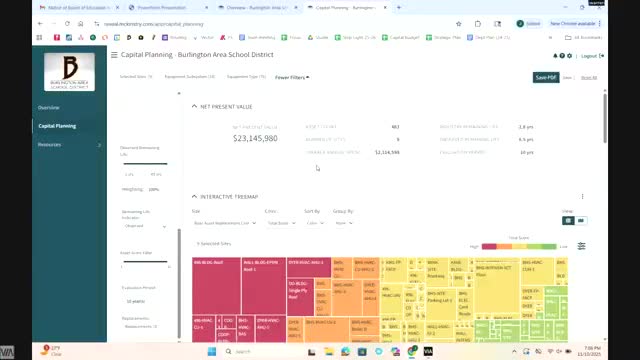District gets $23 million, 10-year facilities plan, plus live 'Reveal' dashboard from McKinstry
November 11, 2025 | Burlington Area School District, School Districts, Wisconsin
This article was created by AI summarizing key points discussed. AI makes mistakes, so for full details and context, please refer to the video of the full meeting. Please report any errors so we can fix them. Report an error »

McKinstry, the district’s facilities consultant, told the Burlington Area School District board on Nov. 11 that its nine-building facilities review identifies roughly $23,000,000 in capital needs over the next 10 years — an average of about $2,300,000 a year — and showed a live Reveal capital-planning dashboard district staff can use to prioritize work.
The presentation was introduced by Jess Warm, the district’s director of buildings and grounds, and delivered by Chris Jones, an account executive with McKinstry, and engineers Claire Eaton and Brent Schmidt. “We’re really excited to show you some of the findings and results of this study,” Jones said during the presentation.
McKinstry explained its methodology: assess each asset’s industry life expectancy, the team’s visual observations and engineering judgment, and the operating environment, then estimate a like-for-like replacement cost. Eaton described the Facility Condition Index (FCI), which expresses replacement need as a ratio of recommended capital replacements to a building’s replacement value. The firm said it used two walkthroughs of the sites and staff interviews to inform observed remaining life and condition ratings.
The consultants said the district’s observed remaining life average is +6.5 years versus an industry-average baseline the study cites as negative three years; their ten-year projection sums the district’s deferred and upcoming replacements into a $23 million figure. McKinstry also reported the district’s nine buildings have roughly $630,000 in total annual utility costs and that, on energy metrics, several buildings perform in the top half compared with peers in the state.
McKinstry demonstrated Reveal, a web-based dashboard that collects asset-level observations and replacement-cost estimates and lets users click a building to view year-by-year capital needs, item-level notes and severity scores. Eaton highlighted a sample item — the roof on the district’s 496 McKenna Parkway building — showing installation year, observed life, a condition score and a replacement cost assigned in the tool.
Board members asked whether the study recommends alternatives to like-for-like replacement (for example, more efficient boilers or upgraded roofing systems). Eaton said those conversations follow the capital-planning exercise and that Reveal is intended to surface trade-offs and prioritize projects in constrained budgets. “This tool would then lead to those conversations,” she said.
District staff and McKinstry noted the study’s capital total is an inventory of everything that could be done over 10 years, not a proposal to spend that amount immediately. The board discussed practical steps: staff will be trained on Reveal and return to the buildings-and-grounds committee to translate the study into a strategic, prioritized plan that matches available funding and grant opportunities.
What happens next: district staff will be trained on Reveal, McKinstry will support refined capital planning and the buildings-and-grounds committee will meet in January to review prioritization and scheduling recommendations. The board did not take formal action on the McKinstry report at the meeting.
The presentation was introduced by Jess Warm, the district’s director of buildings and grounds, and delivered by Chris Jones, an account executive with McKinstry, and engineers Claire Eaton and Brent Schmidt. “We’re really excited to show you some of the findings and results of this study,” Jones said during the presentation.
McKinstry explained its methodology: assess each asset’s industry life expectancy, the team’s visual observations and engineering judgment, and the operating environment, then estimate a like-for-like replacement cost. Eaton described the Facility Condition Index (FCI), which expresses replacement need as a ratio of recommended capital replacements to a building’s replacement value. The firm said it used two walkthroughs of the sites and staff interviews to inform observed remaining life and condition ratings.
The consultants said the district’s observed remaining life average is +6.5 years versus an industry-average baseline the study cites as negative three years; their ten-year projection sums the district’s deferred and upcoming replacements into a $23 million figure. McKinstry also reported the district’s nine buildings have roughly $630,000 in total annual utility costs and that, on energy metrics, several buildings perform in the top half compared with peers in the state.
McKinstry demonstrated Reveal, a web-based dashboard that collects asset-level observations and replacement-cost estimates and lets users click a building to view year-by-year capital needs, item-level notes and severity scores. Eaton highlighted a sample item — the roof on the district’s 496 McKenna Parkway building — showing installation year, observed life, a condition score and a replacement cost assigned in the tool.
Board members asked whether the study recommends alternatives to like-for-like replacement (for example, more efficient boilers or upgraded roofing systems). Eaton said those conversations follow the capital-planning exercise and that Reveal is intended to surface trade-offs and prioritize projects in constrained budgets. “This tool would then lead to those conversations,” she said.
District staff and McKinstry noted the study’s capital total is an inventory of everything that could be done over 10 years, not a proposal to spend that amount immediately. The board discussed practical steps: staff will be trained on Reveal and return to the buildings-and-grounds committee to translate the study into a strategic, prioritized plan that matches available funding and grant opportunities.
What happens next: district staff will be trained on Reveal, McKinstry will support refined capital planning and the buildings-and-grounds committee will meet in January to review prioritization and scheduling recommendations. The board did not take formal action on the McKinstry report at the meeting.
View full meeting
This article is based on a recent meeting—watch the full video and explore the complete transcript for deeper insights into the discussion.
View full meeting
